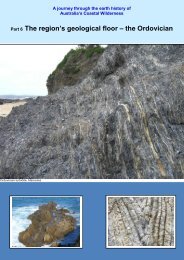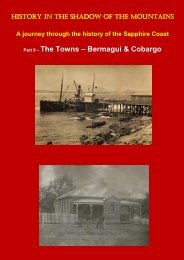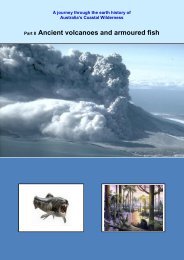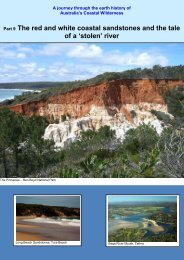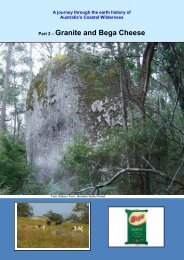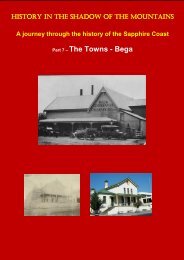Part 6 â The towns â Pambula - Sapphire Coast
Part 6 â The towns â Pambula - Sapphire Coast
Part 6 â The towns â Pambula - Sapphire Coast
- No tags were found...
Create successful ePaper yourself
Turn your PDF publications into a flip-book with our unique Google optimized e-Paper software.
HISTORY IN THE SHADOW OF THE MOUNTAINSA journey through the history of the <strong>Sapphire</strong> <strong>Coast</strong><strong>Part</strong> 6 – <strong>The</strong> Towns - <strong>Pambula</strong>
<strong>Pambula</strong>(Town map on the last page)<strong>The</strong> name <strong>Pambula</strong> is derived from its Thawa language name pronounced"Panboola", meaning 'twin waters'. <strong>The</strong> suffix ‘bula’ or ‘boola’ is seen in the names ofother places in the region. For example Merimbula, that means ‘twin lakes’. Many ofthe Aboriginal names for places on this part of the coast have been retained orreinstated – Gulaga Mountain was called Mt Dromedary by Captain Cook when hesailed up this coast.<strong>The</strong> Imlay Brothers, Peter, George and Alexander, settled in this area in the 1830s,taking up land on the <strong>Pambula</strong> Flats for agriculture. Agriculture is still the dominantland use here.Although initially laid out by Surveyor Townsend in 1843, <strong>Pambula</strong> was notproclaimed a town with its new name until 1885. <strong>The</strong> main land uses were grazingand agriculture. Initially people lived in tents along stock routes but these werereplaced by slab and bark huts, then by more permanent buildings, houses,blacksmith huts and hotels. <strong>Pambula</strong> had five licensed hotels by 1856 and thefoundation stone for the courthouse was laid in 1860.Surveyor Townsend originally planned the village of <strong>Pambula</strong> on the flats near theriver and the first school and churches were built there. However, because offrequent flooding the village was relocated to its present site on higher ground. <strong>The</strong>flooding still occurs today and major road works are required to keep the PrincesHighway open.Midshipman John Lloyd C1806, from "John Lloyd RN of the Grange", by H. S. BazleyJohn Lloyd and <strong>The</strong> GrangeCaptain John Lloyd, Royal Navy, acquired land in 1844 using his severance pay onleaving the Royal Navy. He entered the Navy at just 12 years of age, and at 14,fought in the Battle of Trafalgar. Captain Lloyd built ‘<strong>The</strong> Grange’, a stately colonialhome still standing on the hill in South <strong>Pambula</strong> near the river. A section of ‘<strong>The</strong>Grange’ has been refurbished as a restaurant.
<strong>The</strong> GrangeLloyd employed two local men to construct his homestead, but it is likely that he alsohad two convicts assigned to him who may have worked on the building. Stone forthe two storey residence was reputed to have been carried out from Devon (England)as ship’s ballast. Although commanding in appearance from the exterior, the buildingis of a very simple design inside, the two floors being divided into four rooms each,separated by an eight-foot wide hallway running down the centre.Just below the house was a large water hole popular with the Aboriginal people, and,according to later recollections, was the site of many battles between local groupsand neighbouring Monaro Aboriginals who came down to coast during the wintermonths. According to oral history, this was also the site of a massacre ofAboriginals, when the waterhole was poisoned.Syms CovingtonSyms CovingtonJohn Lloyd invited Syms Covington to move to <strong>Pambula</strong>. When he was 15 years oldCovington joined Charles Darwin on his second survey expedition in the HMS Beagleas a fiddler and cabin boy. As well as working as a servant and general secretarywriting out Darwin's records of investigations, Covington became Darwin's assistantas a collector, hunter and taxidermist. Covington kept a personal journal of hisimpressions of the voyage that includes accounts ranging from daily mundane tasksto his impressions of the lands and the people he encountered. His journal is a
valuable perspective that supplements Darwin's Journal and Remarks, better knownas <strong>The</strong> Voyage of the Beagle.Charles Darwin Voyage of the Beagle 1831-1836After the Beagle returned in 1836, Covington became Darwin's manservant andcontinued his duties. Covington’s collection of bird specimens was to proveinvaluable because he had taken care to record on the label, the place eachspecimen had been taken (unlike Darwin). His careful labelling enabled each ofDarwin’s finches to be identified with a specific island in the Galapagos Islands.Covington remained in Darwin's service until 25 February 1839. He then decided toemigrate, and was given a personal reference from Darwin in a letter dated 29 May1839.Records indicate that Covington landed in Sydney in 1840. He married Eliza Twyfordand drew on his naval connections to find employment, and by 1843 was working asa clerk at the Sydney coal depot of the Australian Agricultural Company. Around1844 the family, with their first two sons, accepted the invitation of Captain Lloyd andmoved to the south coast property at <strong>Pambula</strong>.Covington continued to correspond with Darwin, who sent him the gift of areplacement ear trumpet to help with Covington's increasing deafness, supposedlythe result of his shooting of specimens for Darwin. In response to Darwin's requestfor local specimens, Covington and his eldest son collected a large number ofbarnacles at nearby Twofold Bay. Darwin's letter of 23 November 1850 expressedhis delight in receiving the box, which included particularly unusual species. Thiscontributed to the extensive studies of barnacles that established Darwin as abiologist.Covington became Postmaster of <strong>Pambula</strong> in 1854 and later managed an inn. Hedied in 1861 of 'paralysis' at only 47 years old. Covington’s house still stands and iscurrently a gallery open to the public.
Covington’s House and galleryPanboola Wetlands<strong>The</strong> Panboola wetlands<strong>The</strong> original site for the <strong>Pambula</strong> town has now been returned to nature. Panboola isa 77 hectare area of floodplain managed by the <strong>Pambula</strong> Wetlands and HeritageProject in conjunction with the <strong>Pambula</strong> Wetlands and Heritage Reserve Trust.Since 1997 changes in ownership and use of this land led to the restoration ofPanboola as it might have originally been. Panboola is being rehabilitated as awetland for the purposes of nature conservation, protection and restoration of habitatfor birds and other indigenous flora and fauna, and for community education andoutdoor enjoyment. Fresh water billabongs lead to saline areas within and aroundthe former racecourse, then through salt marsh and mangroves to the tidal <strong>Pambula</strong>River beyond. A system of walking tracks is being developed.<strong>Pambula</strong> GoldfieldWhen gold was discovered near <strong>Pambula</strong> in 1889, small shanty<strong>towns</strong> grew uparound the diggings. <strong>The</strong> <strong>Pambula</strong> Goldfield is listed on the Register of the NationalEstate. <strong>The</strong> area is unusual in that it contains many diverse mining remains in arelatively compact area. <strong>The</strong>se include examples of mining technology that are rarein Australia.Yowaka and Pipeclay Creek village sites, with their range of mining, processing andliving areas, demonstrate well the various characteristics of a gold mining area.
In 1888 gold was discovered on Mount Gahan in what is now part of the Nullica StateForest. In the rush that followed, claims were staked all around the discovery site.Shafts were sunk 100m or more and drives were cut in all directions. <strong>The</strong>se mineswere abandoned, never to be reopened. <strong>The</strong>y survive virtually as they were whenabandoned at the end of the 19th century. In the early years of the 20th century, afourth lode was discovered well to the south. This was the ‘Brass Knocker’, workedsuccessfully from 1911to 1912 and on and off during the 1920s and 1930s.To get to the <strong>Pambula</strong> Goldfield turn west off Nethercote Road after the PipeclayCreek crossing. <strong>The</strong>re are three major weirs situated on Pipeclay Creek, the largestabout 50m wide and the smallest 10m wide. <strong>The</strong>y are made of brick and are still inexcellent condition. An impressive water reticulation system once supplied water tovarious machinery sites. Mud brick processing vats and many building sites liehidden in the undergrowth among the debris left behind. Massive flywheels, steampistons and other relics can be seen near the Faulkiner workings. Much of the orecrushing took place here in a two-storey building and the brick kiln is an example offine craftmanship. Flying foxes carried ore to this and other locations 1,500ft down a400ft elevation, from the Mount Gahan Mine to the lower areas of Pipeclay Creek. Onthe Mount Gahan Ridge, which has commanding views of <strong>Pambula</strong>, a number ofmajor shafts hundreds of feet deep dot the hillside. It was here that the Yowakavillage was situated. <strong>The</strong> hillsides have flattened plots, stone foundations andfireplaces - the remains of what had been the bustling community of homes, shopsand pubs of a generation of pioneers. Hundreds of building sites can be discernedcrowding the ridge. <strong>The</strong> <strong>Pambula</strong> Goldfield was at its most active from 1889 untilWorld War 1.<strong>Pambula</strong> Heritage Walk<strong>Pambula</strong> village has retained many fine old buildings and a walk through the streetsand a drive around the surrounding area will invoke a sense of Australia's pioneerpast. Of course, the uses of the buildings have changed. <strong>The</strong>re are now artgalleries, clothing shops, an artisan bakery, coffee houses (one in a converted bankthat is an extensive providore), a wholefoods store and other special interest shops.
Courthouse, Police Station and Cell BlockFormer <strong>Pambula</strong> Courthouse, police station and cell blockListed on the Register of the National Estate, the former <strong>Pambula</strong> Court House,Police Station and Cell Block are important for their role in the administration ofjustice in <strong>Pambula</strong> from the time the site was first used for a lock-up in 1859, until theclosure of the courthouse in 1984.<strong>The</strong> complex of buildings has a long association with the social history of <strong>Pambula</strong>and, despite being no longer used for its original purpose, continues to be of socialvalue to the local community as a centre for the study of family history and forcommunity group meetings.Oaklands HomesteadOaklands homestead‘Oaklands’ homestead is listed on the New South Wales Heritage Register because itis a rare example of an intact colonial homestead from the late Georgian period. <strong>The</strong>main homestead, built in 1842, together with its outbuildings and immediate garden,is one of the oldest buildings in the Bega Valley and one of the earliest survivingcolonial houses on the New South Wales south coast. It is mentioned here becauseof its significance to the state and the region, but because it is privately owned, it isnot open to the public. It can be seen from a distance from ‘<strong>The</strong> Grange’ (Lloyd’shouse, described above).
<strong>Pambula</strong> district (Google Earth)




